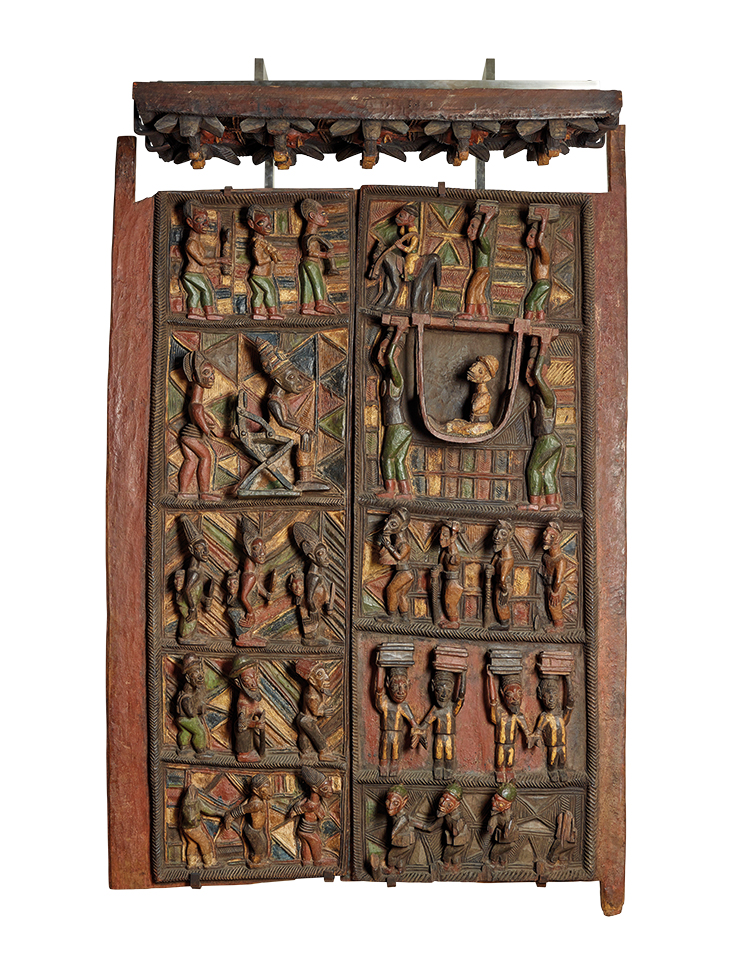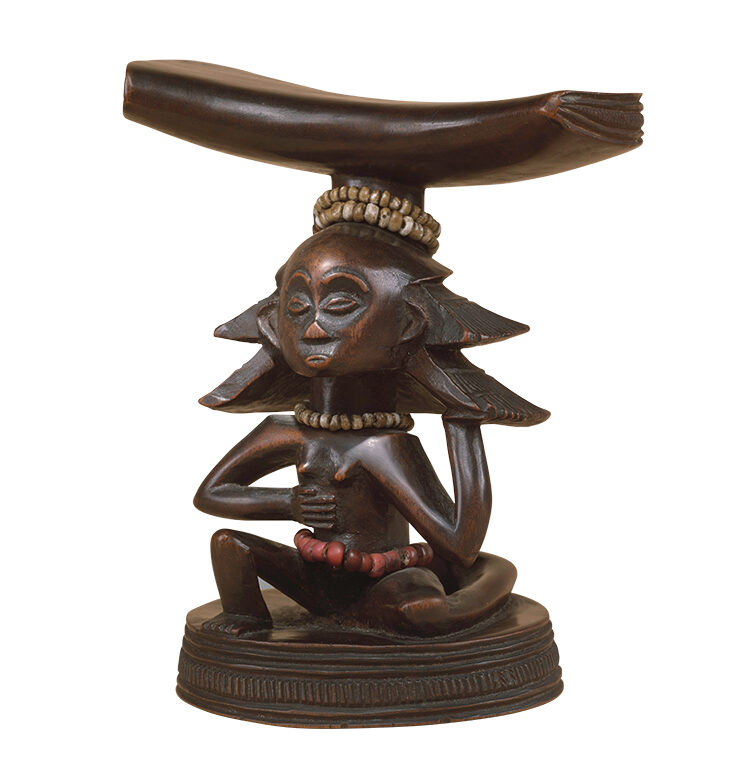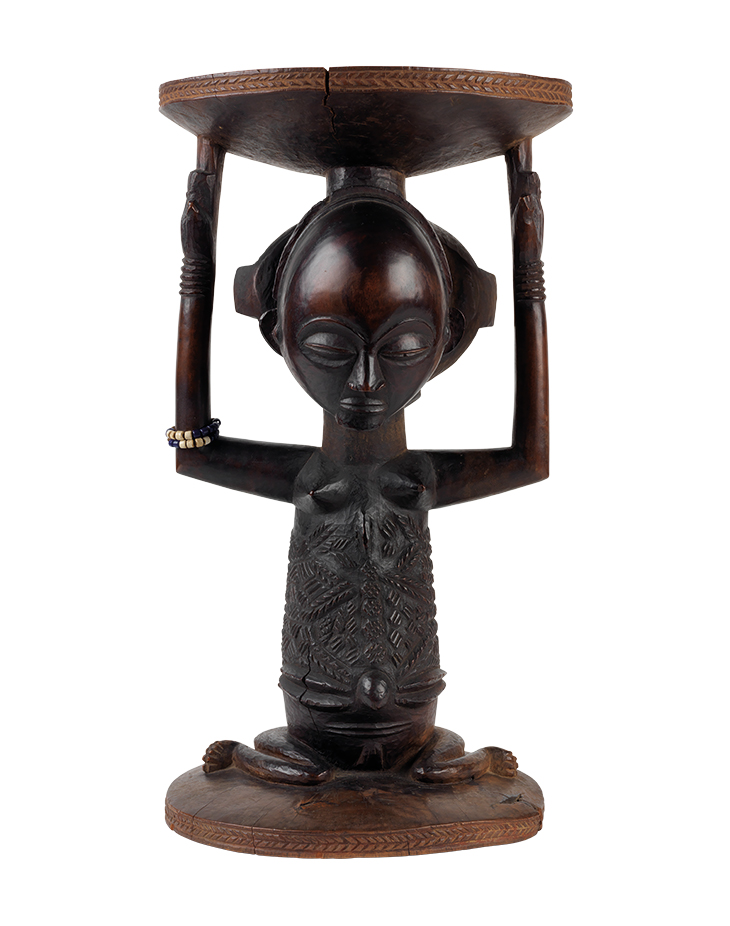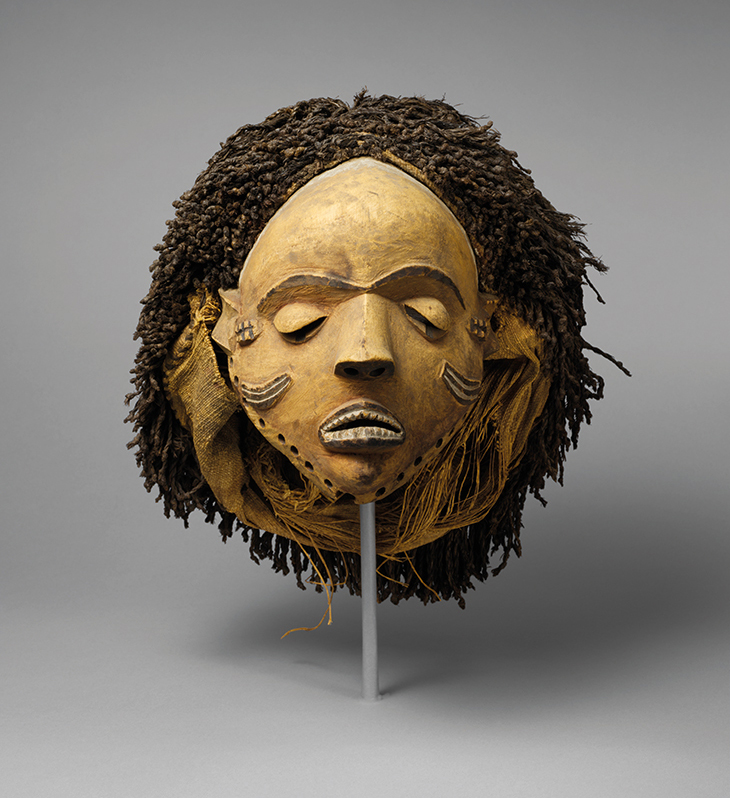Of the hundreds of thousands of artefacts valorised for the creative ingenuity of their makers across sub-Saharan Africa, and now in museums and private collections around the world, few are identified by name. From societies in which history and praise were relayed orally we are left with no literal signatures. This is not a reflection of enormous temporal divides, as it is with ancient archaeological artefacts. Instead it reflects a paradoxical legacy of Western collecting: on the one hand, the material aspect of complex traditions was historically privileged over all else; on the other, different standards were applied to the recognition of African makers’ achievements than those of their Western contemporaries.
Such collecting practices decoupled intangible and material heritage. But beyond that fact, it is disconcerting that, given the opportunity to document the material record, little effort was made to do so. Whether these objects were collected in the 19th century or the 1970s, and despite the fact that most were no more than a few generations old at the time, we are left with generic attributions to entire ethnic groups and equally vague dates, often spanning centuries. This lack of precision concerning material culture relating to an entire subcontinent has contributed to public assumptions about the lack of importance originally placed on recognising the individual men and women responsible for the objects’ creation.
Just over 20 years ago I sought to refute the notion of authorial irrelevance with ‘Master Hand: Individuality and Creativity Among Yoruba Sculptors’ at the Metropolitan Museum of Art, New York – an exhibition that drew on the rich and extensive literature by Yoruba intellectuals, as well as several generations of art-historical research. The presentation outlined a creative process, examined the significance of particular sculptural genres and their interpretation by a range of individuals, and gave prominence to the authors through archival photographs and the Yoruba praise poetry that evoked their contributions and place in society. It is, however, impossible to generalise about Africa, and not least in the realm of creative expression; it is instead best defined by its immense diversity of cultures, each of which has fostered an array of distinct visual traditions. In his groundbreaking book The Invention of Africa (1988), the philosopher V.Y. Mudimbe emphasises African art’s ‘amazingly diverse, complex, and conflicting regional styles’ and the need to consider these ‘as we do literary texts’. In what follows, I offer three case studies, each of which highlights a culturally specific perspective on the significance of authorship; together, they suggest how pervasive assumptions about African sculpture reflect a widespread misreading of an array of distinct creative processes.
*
The first of these is the example of Olowe of Ise (or Olowere; c. 1875–1939), maker of an elaborately carved portal from the entrance of the Ikere Palace in Nigeria, now in the British Museum. The work was commissioned by Onijagbo Obasoro Alowolodu, the Ogoga of Ikere, who is himself depicted in the left-hand panel’s second register. Only a decade after its completion, it was lent by its Yoruba patron to be exhibited at the British Empire Exhibition, London, in 1924. What was at that time a recently completed regional landmark was displayed ostentatiously with no acknowledgement of its living author. Reaction to the work was so enthusiastic that the British Museum presented the Ogoga with an offer to acquire it for the national collection. There it remained anonymous for the next quarter of a century.
Ikere Palace door and lintel (c. 1910–14), Olowe of Ise, Yoruba peoples, Nigeria. British Museum, London

The Ogoga received a British-made throne in exchange and commissioned a replacement portal from Olowe in 1925. Rather than merely produce a copy of the original, the artist responded by carving a radically different composition; Yoruba palace decor was updated, reflecting how this society placed a premium on innovation. Roslyn Adele Walker, the author of the first monograph on Olowe and a curator at the Dallas Museum of Art, notes that from the 1940s on, many affluent Nigerian patrons replaced sculpted wood veranda posts and architectural features with concrete-covered adobe pillars. It is likely that the replacement portal of 1925 was itself eventually displaced by a renovation scheme; it is now in the collection of the Detroit Institute of Arts.
The painstaking reconstruction of this art history by Walker culminated in the first catalogue raisonné of a pre-20th-century African artist, published in 1998. Until then, the achievements of Olowe of Ise had been enumerated and celebrated locally in performed oriki, or praise poetry, and through photographic documentation. More recently, the art historian Rowland Abiodun has identified a photograph of the artist himself. While it is not known when he learned to carve, Olowe began his career as a lowly messenger at the court of the Arinjale of Ise; in oriki, he is credited with sculptural programmes developed for the palaces at Ise, Ikere, Owo, and Akure.
The portrait that emerges is of a professional sculptor, from whom the most ambitious Yoruba patrons of his day sought works that were highly visible. Despite this, as Walker notes, prevailing biases were such that the official who selected the Ikere palace doors for display in London likely never thought to ask: ‘Who made this?’ It was not until after the Second World War that Olowe was recognised outside the Ekiti region as its author (by Philip A. Allison, a British forester stationed in Nigeria from 1931–59).
The artistic vision that informed Olowe’s approach is evident in the corpus assembled by Walker. The criteria used to assess his achievements are the subject of a rich Yoruba tradition of aesthetic commentary; following the completion of a sculpture, its evaluation began with a ritual announcement: ‘there ends the work of the sculptor/Let the critic start his own.’ The philosopher Olabiyi Yai emphasises that the response of a Yoruba critic never simply addresses the formal appearance of an isolated work but instead expansively invokes its carver, orisa (deities), patrons, viewers, and even the critic’s own role as commentator.
In the lexicon of Yoruba criticism sa is the verb which means ‘to select, to discern, to discriminate’, while asa is the noun used to denote the concept of ‘tradition’. In his execution of the architectural elements he designed to frame the entrances of grand residences and shrine portals as well as pillars for interior courtyards, Olowe followed the asa, developed in Ekiti-Yoruba centres. Da asa, informed departure or break with tradition, drove his expansion beyond those parameters. Contemporaries, such as Areogun of Osi-Illorin, elected to underscore the bilateral symmetry of their sculptural programmes for doors and filled their surfaces with frontal figures. In contrast, Olowe’s oju-ona, or design consciousness, is expressed through figures that extend beyond their picture frame and an allocation of space in asymmetrical panels driven by the subject matter presented. The dynamism of those compositions is further enlivened with a sense of movement and highly complex incised graphic surfaces.
Ise Palace door (Ilekun aafin) (c. 1904–10), Olowe of Ise, Yoruba peoples, Nigeria. Metropolitan Museum of Art, New York

These principles are manifest in the palace door produced between 1904–10 for the Arinjale of Ise to commemorate his meeting with the British travelling commissioner Captain Ambrose at the turn of the century. According to Walker it was this work that inspired the Ogoga of Ikere to enlist Olowe’s talents to produce the door and lintel now at the British Museum. The Ise portal’s right panel is now in the Smithsonian’s National Museum of African Art and the left is a recent promised gift to the Met. While these material products of Olowe’s ingenuity are credited to him as an author, to reflect upon his impact it is necessary to evoke more fully the complex network of creative forces within which he operated – including the local context of patronage and aesthetic assessment in Yoruba society, which thrived on change.
*
The first study devoted to an African artist, the so-called Buli Master, was prompted by the striking style of sculptures that have since been found not to refer to the work of a single individual but to a workshop. Luba leaders in the Katanga region of south-eastern Democratic Republic of the Congo were patrons of sublime sculptural artefacts. Critical to a Luba chief’s investiture rites and legitimacy, such insignia of divine kingship, consecrated by spirit mediums and held in treasuries, were rarely visible. The major repository of that legacy today is the Africa Museum (or Royal Museum for Central Africa) at Tervuren, founded in 1897 by King Leopold II of Belgium to advertise the resources of his private colony, the Congo Free State. From the many 19th-century Luba works that arrived in Belgium during the colonial era, in 1947 the Flemish anthropologist Frans Olbrechts identified several as the creative output of a master of ‘the long-faced style’, or master from the town of Buli. (Olbrechts was a pioneer among Europeans in questioning the anonymity of African artists and advocating for intensive first-hand interviews and field research; his approach, in which universalist aesthetic evaluations are applied to decontextualised art, has been criticised for its ethnocentrism.)
The arrival of princely figures from the east ushered in the beginnings of the Luba state around 1400. The culture hero Mbidi Kiluwe introduced enlightened governance to the Luba, and his son Kalala Ilunga was the first legitimate sovereign. According to Luba ideology, every subsequent ruler is a personification of these bearers of culture. The art historian Mary Nooter Roberts has underscored that, in parallel, Luba title-holders and court historians to this day emphasise the conflation of all Luba insignia of office with their legendary prototypes – including staffs of office, carved ceremonial seats and bow stands, the most elaborate of which incorporate visual evocations of the source of life and perpetuation of sacred kingship in the form of female figures.
Headrest (19th century), Master of the Cascade Coiffure, Luba or Shankadi peoples, Democratic Republic of the Congo. Metropolitan Museum of Art, New York

The forging of iron is among the technical innovations attributed to Mbidi Kiluwe. Roberts notes that Luba woodcarvers were generally blacksmiths who emphasised their connection to an originary past over individual creative identities. Accordingly, their production of sculpture, whether for Luba kings or foreign patrons, has been characterised as reworking and giving new life to pre-existing ideas. The records relating to hundreds of these artefacts now in Tervuren trace many of those that are most artistically admired in the West to eastern Luba territories. Despite such documentation, however, there is never any mention of the names of their creators. Roberts poses the question of whether this is simply a reflection of the brutal colonial mindset that dehumanised its subjects and requisitioned treasures. Although this may have contributed to the loss of information, she notes, the context in which such works were produced as sacred carriers of divine kingship consecrated by a spirit medium subsumed individual achievement into networks of royal patronage and ritual use.
Despite the Luba conceptual emphasis on reproducing ‘prime creations’, a diverse array of distinctive approaches to their formal interpretation is evident in the corpus of 19th-century Luba sculptures. In the absence of attributions to specific individuals, these works have been ascribed to an array of workshops, or ‘hands’. These stylistic groupings suggest that ateliers specialised in particular genres, rather than the full array of insignia found in a single leader’s treasury.
Seat of leadership (19th century), Buli Master, possibly Ngongo ya Chintu, Luba or Hemba peoples, Democratic Republic of the Congo. Metropolitan Museum of Art, New York

Since Olbrechts’ original attribution of several works to a Buli Master, that corpus has grown to some 20 objects. It appears that they are the work of several generations of sculptors based at the crossroads of the Luba and neighboring Hemba regions. A number of these are seats of office featuring caryatid figures. One of these, acquired by the Met in 1979, was the focus of an exhibition introducing the Buli Master in 1980. In this example, a female caryatid is framed by circular discs of the seat balanced on the crown of her head and a base. Eyes cast downward, she bears the weight of the world on the tips of fingers that extend from broad flattened hands to grasp either rim of the seat. The soft, expressive exaggeration of such ‘Buli’ creations contrasts sharply with the crisply defined idealisation of those by a contemporaneous master labelled ‘Warua’ (a term used by Swahili traders to refer to Luba and related people) by the German ethnographer Leo Frobenius in 1904. That corpus of especially refined works includes several ceremonial bow stands and three caryatid seats.
Prestige stool (Kipona) (late 18th–early 19th century), Master of the Warua or the Kunda, Luba peoples, Democratic Republic of the Congo. Metropolitan Museum of Art, New York

A further workshop was responsible for some 20 exquisitely carved headrests, or ‘pillows’, designed to preserve their owners’ elaborate labour-intensive hairstyles while in repose. Likely produced in the Luba heartland, they are associated with a master from the Shankadi region. The focal points of these more intimate prestige items are female figures who themselves model one of the most popular coiffures of the latter half of the 19th century, as worn around the towns of Kamina and Kabondo Dianda. The layered parallel steps of this ‘cascade style’ project laterally, echoing the slightly bowed horizontal neck support at the summit. The dynamism of that crowning element is amplified by the fluid asymmetrical postures of the figure. Field research has suggested that the enduring appeal of such widely favoured, signature carving styles was such that they were perpetuated by as many as three successive generations of sculptors.
*
A Pende mask carved in the DRC at the turn of the 20th century (and held at the Met since 2011) follows culturally established conventions in its representation of Gambanda, an ideal of youthful womanhood. Its author’s command of his idiom is evident in his portrayal of the oval cast of the face; the calm, level forehead; the delicate nose; the smooth plump cheeks; the seductive hooded eyes; the fine continuous brow; and the fullness of thick locks of hair. In performance, the allure of this sculptural element’s classic beauty would have been animated by a dancer whose dress, movements and hairstyle embraced fashions of the utmost contemporaneity. As with most Pende masks dispersed internationally, although this work was likely of recent vintage and in use at the time it was acquired in or before 1908 by Émile Lejeune, a Belgian colonial officer, none of the specifics of its origins have been recorded. All we can surmise about its author is that he, like the majority of Pende sculptors of his generation, was a professional blacksmith.
Female mask (Gambanda) (late 19th-first decade of the 20th century), Pende peoples, Democratic Republic of the Congo. Metropolitan Museum of Art, New York

The art-historical research undertaken by Zoë S. Strother at the source during the 1980s allows us to anchor such works to a larger narrative of Pende society at a moment of unprecedented change. Notable among its agents was Gabama a Gingungu (1890s–1965), recognised by Pende cognoscenti as the most accomplished sculptor of the 20th century. By the 1920s Gabama had garnered acclaim both across Pendeland among dancers who favoured his masks and from a foreign clientele who published features on him in the colonial press. Despite this recognition during his lifetime and beyond, at the time of his death those works that had remained in his community were lost in the chaos, looting, and fires that ensued when its members were obliged to evacuate over the course of a rebellion against the Congolese government in the 1960s.
Gabama was instructed by his uncle Maluba, who had himself been entranced by Gizeza of Kasele’s three-dimensional modeling of his subjects. Gabama’s talent and entrepreneurial savvy led to his success as a full-time professional, with a broad market for his work. He founded his own workshop, comprised of several of his sons as well as maternal nephews, which continued into the late 1980s. Delegated to apprentices were time-consuming and labour-intensive tasks of grinding colours and processing the elaborate raffia fibre ‘hair’ added as coiffures. Among the most talented of these proteges, Nguedia Gambembo was eventually allowed to block out a mask for Gabama to complete.
Strother’s interviews and examination of photographic records with sculptors of the generation who followed Gabama led to the attribution of a mask of a chief, or fumu, which entered the Africa Museum’s collection in the early 1930s, to him. Their recognition of his particular style, luholo lu’enji, was made on the basis, Strother writes, of ‘the shape of the face, the handling of the ear, the form of the eyebrows, the prominence given the nostrils, the shape of the mouth, the form of the cicatrices, the manner of working the coiffure’. What he had achieved was to render concretely the complex character of the chief as ‘a man who is unquestionably male, potent, the father of many children, who nonetheless has a command of feminine skills’.
By focusing on the talents of the individual sculptor, however, we run the risk of ignoring or missing out on earlier phases of the creative process of even greater consequence. The launch of a successful new Pende masquerade carried the promise of lutumbu, fame and public acclaim; Gabama’s innovations as a sculptor responded to the call of Pende youth driven by the ambition to add to the repertoire. That process began with their composition of a song, followed by the development of a corresponding dance and the definition of its dramatis personae in advance of consulting a sculptor. The inventor credited with the masquerade performance of Gatomba, Miteleji Mutundu, demonstrated its song and dance to Gabama who in turn gave form to its character through a customised face mask. In such patronage networks, sculptural innovations reflect collaborations between dancers, singers, musicians and sponsors, as well as the carvers who create them. It is in this broader frame of reference that we ought to consider the Pende mask now at the Met.
The questions we ask about the achievements of others are a measure of our own curiosity and engagement. These Yoruba, Luba, and Pende case studies suggest what is likely missing from the record of many other traditions. They also signal that authorship cannot simply be reduced to a single name. In the instances in which we are able to retrieve that information, it is urgent that we do so, as a measure of respect and means to deepen and enrich appreciation of the achievements of gifted individuals within their respective creative networks. With the passage of time, it is increasingly unlikely that this can be achieved with any degree of specificity – and where that is the case, it is important to draw attention to the dearth of specific names, as a real and significant loss. Doing so carries with it the need to provide accounts of the historical circumstances that contributed to such omissions; and it calls for renewed engagement with the continuation of artistic traditions in contemporary society.
From the December 2020 issue of Apollo. Preview and subscribe here.


